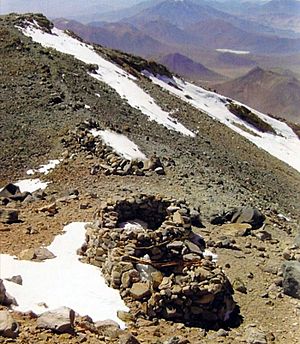Constanza Ceruti facts for kids
Quick facts for kids
Constanza Ceruti
|
|
|---|---|
| Born | 11 January 1973 Buenos Aires
|
| Alma mater | National University of Cuyo |
| Known for | First woman high-altitude archaeologist |
| Awards | Golden Condor Honoris Causa |
| Scientific career | |
| Institutions | Institute of High Mountain Investigations, Catholic University of Salta |
María Constanza Ceruti (born January 11, 1973) is an Argentine anthropologist (a scientist who studies people and culture) and a skilled mountaineer. She is famous for being the world's first female high-altitude archaeologist. This means she explores ancient sites on the tops of very high mountains.
Ceruti has explored over 80 sites, often with teams from National Geographic. Her most famous discovery was the Children of Llullaillaco. These are three Inca mummies that are so well-preserved they are in the Guinness World Records. She found them near the top of a volcano, more than 6,000 meters (about 20,000 feet) high!
She is a top researcher in Argentina and teaches Inca Archaeology at the Catholic University of Salta. She also started the Institute of High Mountain Research. Ceruti travels the world to study sacred mountains and learn how they are important to different cultures.
Contents
Early Life and Education
Constanza Ceruti was born in Buenos Aires, Argentina. She was a brilliant student and went to the University of Buenos Aires. She graduated in 1996 with a degree in anthropology and the university's Gold Medal for being a top student.
In 2001, she earned her Ph.D. from the National University of Cuyo. She was the first person to specialize in the archaeology of high-altitude mountains.
A Dangerous Job
Being a high-altitude archaeologist is very challenging and dangerous. Ceruti has climbed over one hundred mountains taller than 5,000 meters (16,400 feet) for her research.
The work involves long and difficult climbs in extreme weather. Ceruti explained the challenges:
Climbing high mountains requires great physical strength, as the journeys are very long, sometimes more than twenty hours. The environment has a shortage of oxygen, low air pressure, strong icy winds, snow, and thunderstorms. The extreme cold freezes the batteries in cameras and fingertips in seconds... the lack of oxygen affects concentration, while an archaeologist's work requires a lot of focus.
Despite the dangers, her work has led to amazing discoveries about the past.
Major Discoveries
Ceruti has worked on many important archaeological sites. In 1998, she helped excavate a site on the Misti volcano in Peru. There, her team studied the remains of six human sacrifices from over 500 years ago.
In 1999, she led an expedition up the Nevado Quehuar volcano. Her team found the remains of a mummified child. Sadly, the site had been damaged by treasure hunters, but Ceruti and her team carefully saved the child's remains.
The Children of Llullaillaco
A few weeks after the Quehuar expedition in 1999, Ceruti and her team climbed the Llullaillaco volcano. At 6,739 meters (22,110 feet), it is the highest archaeological site in the world. There, they made an incredible discovery: the perfectly preserved bodies of three Inca children.
The children, a six-year-old girl, a seven-year-old boy, and a fifteen-year-old girl, had been part of an important Inca ceremony called a capacocha. They were buried with beautiful objects, including pottery, bags, jewelry, and small statues.
Because of the extreme cold and dry air, their bodies were naturally mummified and are considered the best-preserved mummies in the world. They are now cared for at the Museum of High Mountain Archaeology in Salta, Argentina.
What We Learned from the Mummies
For years, scientists studied the mummies. They learned that the children were from important families because they were healthy and well-fed. By studying their hair, scientists found that in their last year, the children ate a special diet that included corn and coca leaves. Coca leaves can help people deal with the effects of high altitude.
The children had traveled for months from the Inca capital of Cuzco, Peru, to the mountain where they were found. DNA tests showed they were not related to each other. The oldest girl, known as "The Maiden," and the young boy died from the extreme cold. The youngest girl died from a lung problem caused by the high altitude.
Awards and Recognition
Constanza Ceruti has received many awards for her brave and important work.
- 1997: Named Mountaineer of the Year in Argentina.
- 2000: Received the Golden Condor, the highest award from the Argentine Army for mountaineering. She was the first woman to ever receive it.
- 2005: Named an Emerging Explorer by the National Geographic Society.
- 2007: Won the Women of Discovery Award for Courage.
- 2014: Received an Honorary Doctorate from Moravian College in Pennsylvania, USA.
- 2017: Awarded the Gold Medal from the International Society of Woman Geographers.
- 2019: Became a member of the National Academy of Sciences of Buenos Aires.
See also
 In Spanish: Constanza Ceruti para niños
In Spanish: Constanza Ceruti para niños


